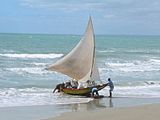Couta
A couta boat is a type of boat sailed in Victoria, Australia, around Sorrento and Queenscliff and along Victoria's west coast as far west as Portland. It was originally used as a traditional fishing boat around the coast there from around 1870 until the 1930s, although it survived as a commercial fishing vessel until the 1950s.
The couta boat developed for the coastal fishing industry over the later part of 19th century. Fishermen chased such sought-after fish often incorrectly identified as 'barracouta'; a confusion with the larger ocean species Barracuda. Couta boats caught the species "Thyrsites atun") but fishing co-operatives established quotas to control prices, and it was this that led to the added requirement of speed in a good fishing boat.
The boats would head out to the grounds before dawn, most often out through the entrance to Port Phillip, the infamous and often treacherous The Rip, which is where the couta boats’ qualities of seaworthiness were proven. Once their quota of barracouta was met, the fishermen turned their efforts to sailing back to port as fast as they could — the first boat back got the best prices.
So while load carrying capacity was important, the need for speed under sail was also a sought-after characteristic. The typical couta boat carried a gaff sail and jib set out on a long bowsprit, although the main sail developed into more of a gunter sail, as it had a very high peaked gaff or yard. In fact, a rig peculiar to the couta boat evolved, which allowed for sail to be carried a lot higher than was usual at the time, and included the distinctive curved down bowsprit.
As an efficient and competitive commercial fishing vessel, the couta boat reached its peak around the 1920s and 1930s. After the Second World War, the development of engines and the public’s growing preference for shark started to push the couta boat from centre stage.
The couta boat became a victim of the modernisation of the fishing industry after the Second World War, and only survives today due largely to the efforts of a small group of individuals with a keen sense of history and admiration for working maritime traditions. Regretting the apparent inevitability that these distinctive boats would be relegated to the status of a forgotten footnote to Australia’s seafaring history and vanish into obscurity, a few dedicated people sought out and restored, from the late 1970s onwards, the remaining original couta boats that were either still afloat or propped up in backyards along the coast.
But this working fishing craft’s perfect compromise between seaworthiness, speed and capacity has made it today a quintessential recreational sailing boat. Today, couta boats are sought-after and keenly compete in races. Many are built new from scratch, as the supply of originals has been exhausted. There is a couta boat club in Sorrento and one in Queenscliff.


